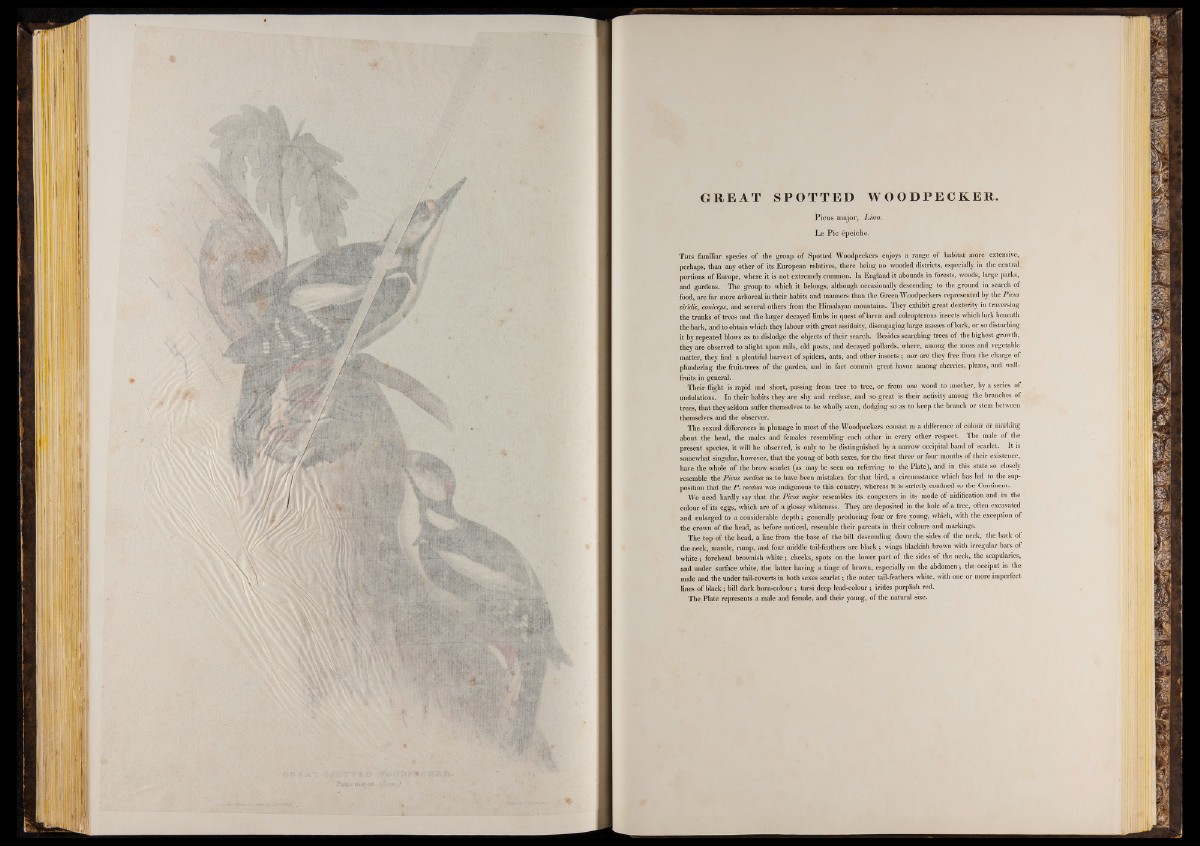
G R E A T S PO T T E D WO O D P E C K E R .
Picus major, Linn.
L e P ic ¿peicfae.
T his familiar species o f the group of Spotted Woodpeckers enjoys a range of habitat more extensive,
perhaps, than any other of its European relatives, there being no wooded districts, especially in the central
portions of Europe, where it is not extremely common. In England it abounds in forests, woods, large parks,
and gardens. The group to which it belongs, although occasionally descending to the ground in search of
food, are far more arboreal in their habits and manners than the Green Woodpeckers represented by the Picus
tiridis, caniceps, and several others from the Himalayan mountains. They exhibit great dexterity in traversing
the trunks o f trees and the larger decayed limbs in quest of larvae and coleopterous insects which lurk beneath
the bark, and to obtain which they labour with great assiduity, disengaging large masses o f bark, or so disturbing
it by repeated blows as to dislodge the objects o f their search. Besides searching trees of the highest growth,
they are observed to alight upon rails, old posts, and decayed pollards, where, among the moss and vegetable
matter, they find a plentiful harvest of spiders, ants, and other insects ; nor are they free from the charge of
plundering the fruit-trees of the garden, and in fact commit great havoc among cherries, plums, and wall-
fruits in general.
Their flight is rapid and short, passing from tree to tree, or from one wood to another, by a series of
undulations. In their habits they are shy and recluse, and so great is their activity among the branches of
trees, that they seldom suffer themselves to be wholly seen, dodging so as to keep the branch or stem between
themselves and the observer.
The sexual differences in plumage in most o f the Woodpeckers consist in a difference of colour or marking
about the head, the males and females resembling each other in every other respect. The male of the
present species, it will be observed, is only to be distinguished by a narrow occipital band of scarlet. It is
somewhat singular, however, that the young of both sexes, for the first three or four months of their existence,
have the whole of the brow scarlet (as may be. seen on referring to the Plate), and in this state so closely
resemble the Picus medius as to have been mistaken for that bird, a circumstance which has led to the supposition
that the P . medius was indigenous to this country, whereas it is strictly confined to the Continent.
We need hardly say that the Picus major resembles its congeners in its mode of nidification and in the
colour of its eggs, which are of a glossy whiteness. They are deposited in the hole of a tree, often excavated
and enlarged to a considerable depth; generally producing four or five young, which, with the exception of
the crown of the head, as before noticed, resemble their parents in their colours and markings.
The top of the head, a line from the base of the bill descending down the sides of the neck, the back of
the neck, mantle, rump, and four middle tail-feathers are black; wings blackish brown with irregular bars of
white; forehead brownish white ; cheeks, spots on the lower part of the sides of the neck, the scapularies,
and under surface white, the latter having a tinge of brown, especially on the abdomen; the occiput in the
male and the under tail-coverts in both sexes scarlet; the outer tail-feathers white, with one or more imperfect
lines of black; bill dark horn-colour; tarsi deep lead-colour; irides purplish red.
The Plate represents a male and female, and their young, of the natural size.